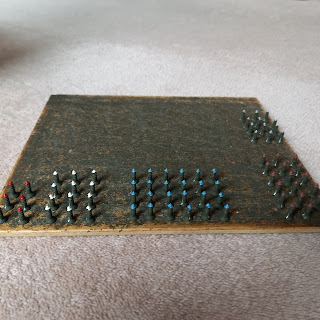THE GERMAN RETREAT.
On the morning of 15th December 1888 General Stuart led three brigades of UNION cavalry south towards the southern bridge over the river Rhine in German Rhineland. At the same time another brigade moved north to secure the smallest Rhine bridge leaving just one brigade to hold the eastern end of the now destroyed central bridge.
In the German high command a state of near panic ensued. Their front line had been burst wide open and UNION forces were seeking to roll up the two German flanks. The main supply line over the Rhine had been destroyed and UNION cavalry were clearly now seeking to complete the encirclement of the German army. All available Militia units, some 25,000 men, were ordered to the southern bridge to secure it. the main German regular reserves stationed around Cologne were ordered forward to counter attack the UNION army and seek to reestablish a coherent front line.
The German counter attack was launched on 18th December but soon faltered under heavy UNION artillery fire. It quickly became clear to the German command that a general retreat was essential. The order was given for all German forces to fall back towards the west. As the retreat gathered momentum, UNION forces found themselves fighting bitter battles with German rearguards. On 19th December the UNION cavalry forces under General Stuart launched an assault on the German militia defending the southern bridge. It soon became clear that the German defenses were too strong for the cavalry. Stuart fell back and opened a long range bombardment of the German positions with his horse artillery. In the north, UNION cavalry found the northern bridge undefended. They quickly demolished the bridge and , following their orders, fell back south towards the central bridge to rejoin the forces there.
The German command were encouraged by the success of the Militia in holding the southern bride and ordered all German forces to fall back towards that bridge. All hope of holding the UNION attack was abandoned. The emphasis was now on ensuring the escape of as many German troops as possible. Over the following weeks as German troops marched west it became increasingly clear that the troops in the northern sector who had been facing Seattle would not be able to reach the escape bridge before the advancing UNION army. They were ordered towards Cologne to defend that town. In the southern area German rearguards were able to hold off UNION assaults giving the main body of troops time to reach the still intact southern bridge. General Stuart realised that, with regular German troops now arriving in large numbers, he needed to move further north to ensure his cavalry did not become trapped between the Militia around the bridge and the retreating regular army. He therefore withdrew back to the central bridge and rejoined his brigades already there.
By the end of January 1889 the German army was concentrated around the southern bridge in huge numbers and under increasingly heavy UNION artillery bombardment. Due to the limited capacity of the bridge the Germans were forced to bring supplies and ammunition over at night with retreating troops using the bridge in daylight. Vehicles and heavy equipment was abandoned as most were too heavy for the bridge. In the centre of the Rhineland a large German force was now besieged around Cologne .
By mid February UNION infantry reached the whole length of the river Rhine except for the part around the southern bridge. German forces there were still seeking to maintain a bridgehead on the eastern end of the bridge but under massive UNION artillery bombardment this was finally abandoned on 21st February. UNION artillery soon moved up and destroyed the bridge next day. Meanwhile around Cologne the German forces were almost out of both supplies and ammunition. The UNION had refrained from bombarding the town due the the number of civilians thought to still be in the town. On 22nd February the German forces surrendered. Some 37,000 German troops marched out of Cologne into UNION prison camps that had been established a few miles east of Cologne.
The German invasion of the UNION had been defeated, the whole of the German Rhineland had been occupied and around 50,000 German civilians were now under UNION control. The German army had lost most of its heavy equipment and vehicles while suffering huge losses in killed, wounded and prisoners. The five UNION armies now in the Rhineland had also suffered heavy casualties and looked forward to rest and recovery.









